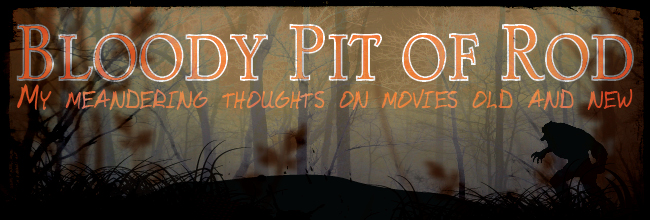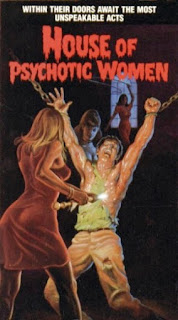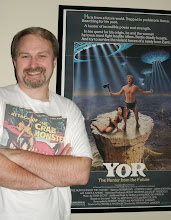*********************************************************************************
Gilles (Paul Naschy) is hitchhiking his way across northern France looking
for a job. Each stop in a small town or village results in sullen stares from the
out-of-work locals, a gentle indicator that he should move on. Trudging down a
dark road one evening he's picked up by Claude (Diana Lorys). She's a pretty
woman with a horribly scarred right arm on which she wears a prosthetic hand.
Gilles apologizes for staring and his questions about how the wounds were
inflicted are bluntly turned aside. But when Gilles asks about work, Claude
offers him the position of gardener/caretaker of the ramshackle estate she
shares with her two sisters. The last employee was let go under bad
circumstances and the unemployed fellow gladly accepts.
On the way to the house the car strikes a bird,
injuring it. When Claude mercifully kills the broken creature Gilles has a
sudden flashback in which he seems to be strangling a woman. Upon arriving at
the estate he meets Nicole (Eva Leon), the redheaded and very flirtatious
sister. The third of the siblings is wheelchair bound Ivette (Maria Perschy).
Claude introduces him and explains that Ivette was injured in an accident
several years before, but declines to give any details. Gilles gets the
impression that the two sisters' different injuries may be related.
The next morning Nicole follows the new hired hand
around, watching him work and making her lustful intentions obvious. In the
afternoon Ivette's new nurse arrives and, much to the surprise of her doctor,
it's not the woman he recommended. Ivette is immediately suspicious of Nurse
Michelle (Ines Morales), a gorgeous blonde, but the family doctor trusts her
and does his best to set his patient's mind at ease. This becomes more
difficult the next day, when it's discovered that the police have found the
murdered body of the originally expected nurse beside the road on the way to
the estate. Hmm. Could Michelle be hiding something sinister? She
certainly acts odd, especially after a tense phone call from an unknown
person. Hmm. And on the sinister side of things, Gilles is plagued by
nightmares repeating the scenario of him strangling a laughing woman... And the
nurse was strangled to death. Hmmmm. Happily for him, Nicole sneaks into his
room on his second evening and administers her own brand of welcome. But is that
a carefully controlled desire to grip her neck the man fights down as he makes
love? Hmm...
Doing yard work the following day, Gilles is attacked
by a knife-wielding maniac. He's able to fight off and even stab the man as he
escapes, but he receives a cut across his stomach. Michelle bandages him up and
he rests the remainder of the day in bed. Claude visits him to explain that the
man with the knife was Jean, the previous caretaker, who was fired for sleeping
with nymphomaniac Nicole. It's clear Claude feels guilty about what happened
and before the evening is over she's prescribed some sexual healing of her own.
That's two of the sisters in the house... Will Gilles go for all three.
Later that night, in the nearby village, a young girl
is attacked and killed while walking home through a cemetery. The victim's eyes
(looking like soft boiled eggs) are gouged out and taken by the murderer. This
second murder in a few days leads the police to fear they may have a serial
killer on their hands. And after a third corpse appears the next
morning — missing its eyes — the cops are in a frenzy to
find the criminal. The single common denominator is that each girl killed had
blonde hair and blue eyes. Hmm. Doesn't the woman in Gilles
flashbacks/nightmares have blonde hair? Hmm.
The police suspect Jean, the missing knife-wielding
ex-caretaker, but Claude does some snooping in Gilles' room and finds old
newspaper clippings. These identify Gilles by another name and relate his past
conviction for raping and killing his fiancée years before. Confronting Gilles
with this information, he breaks down and tells her the details of his past,
gaining her sympathy but leaving a real possibility in the viewer that he's our
black-gloved killer. (Little hint for all ex-convicts trying to leave their
past behind — don't carry around newspaper clippings that detail your criminal
deeds.)
Throwing more confusion into the mix is the discovery
of Jean in a field, dead from the stab wound inflicted by Gilles days
earlier. Hmm. Who is murdering all these pretty young girls?
This is a great little thriller that easily fits into
the giallo genre. Although some purist would argue that only the Italians made
true gialli, I find that a silly and pointlessly limiting way of looking at
European thrillers. This may be a Spanish-made film set in France but it's
clearly a giallo and an inventive one at that. Indeed, I find Blue Eyes of
the Broken Doll to be a strong example of its type with only one serious
flaw — its often off-putting music. But even this flaw isn't a total
disaster. The movie boasts two reoccurring tunes that underscore the story, one
a bouncy piece that we first hear under the credits. While a very catchy song
that I'd love to have on a soundtrack CD, its repeated use in some scenes that
it REALLY doesn't fit works against the tension the film builds. More than once
it plays under a dramatic sequence that it complete deflates with its cheerful
sound. But the other song used is an amazing, sinister version of the old
childhood sing-a-long "Frère Jacque" which is used during the
stalking/attack scenes as the unseen killer picks off the blue-eyed victims.
Sparse and haunting, the song becomes more off kilter and out of tune with each
murder, giving a nice hint of the deteriorating mental state of the
black-gloved strangler.
One of the great joys of any Paul Naschy (real name:
Jacinto Molina) horror film is the feeling of affection for the genre that
always shines through. Even in his lesser efforts it's obvious that he loves
making monster movies and is honestly trying to make the best one he possibly
can. Of course, this sometimes causes them to be so over-earnest in their
seriousness that even a diehard fan can wish that characters would stop whining
and just do something. Pathos and a surfeit of sentimentality often crept into
the screenplays penned by Naschy. But luckily this was before horror film
lengths expanded past the two hour mark so that final act rampage was never too
far away. Also, his desire to inject some romanticism into nearly every story
could come off as forced and silly by turns. These dives into doe-eyed
lovemaking, complete with swelling musical accompaniment, were not helped by
the fact that in nearly every case it was Naschy himself who was rolling around
in the sack with the beautiful actresses. Not that Paul wasn't a fine example
of studly machismo. But when the scriptwriter/actor ends up bedding almost
every gorgeous woman in the film EVERY TIME it becomes a growing source of
amusement. "Hey, Jacinto... How many naked actresses do you get to
paw in this movie?" I suspect that a compilation of just the
lovemaking scenes form his movies strung together one after another would make
a pretty amusing (and lengthy) party tape. The looks of barely restrained lust
are only rivaled in their entertainment value by his intense contortions of
pain and rage during one of his dozens of screen werewolf transformations. For
sheer emotional overkill, Naschy was your man!
Luckily, Blue Eyes of the Broken Doll manages
to avoid the over sentimentality of most Naschy stories. I thought we were
really in for it when Ivette shows up in the wheelchair, but she is never
played for cheap emotion. The character is central to the underlying tensions
between the sisters but is kept mostly in the background, with only her
paranoia about her new nurse giving a view into her inner world.
Of course, the main reason the film is so engrossing is
its central mystery —who is killing the young women around the village?
It's a great puzzle, and even if the final reveal shows that there was no way
at all for a viewer to figure things out it's still a fun tale. The film goes
out of its way to provide clues pointing to several characters, setting up
plenty of red herrings. And even if we know it simply can't be Gilles (because
he's the most obvious choice), his barely suppressed desire to strangle women
does cause a few doubts.
















1 comment:
I read EC reviews everyday on my lunch break. Brian Lindsey and you were my favorite writers to read. I sought out and avoided certain movies thanks to those reviews. Paul Naschy's love of the genre is what captivated me from the start.
Post a Comment